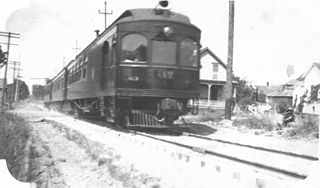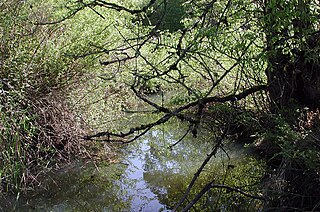
Tigard is a city in Washington County, Oregon, United States. The population was 54,539 at the 2020 census, making it the 12th most populous city in Oregon. Incorporated in 1961, the city is located south of Beaverton and north of Tualatin, and is part of the Portland metropolitan area. Interstate 5 and Oregon Route 217 are the main freeways in the city, with Oregon Route 99W and Oregon Route 210 serving as other major highways. Public transit service is provided by TriMet, via several bus routes and the WES Commuter Rail line.

The Oregon Electric Railway (OE) was an interurban railroad line in the U.S. state of Oregon that linked Portland to Eugene.

The Portland metropolitan area is a metro area with its core in the U.S. states of Oregon and Washington. It has 5 principal cities the largest being Portland, Oregon. The U.S. Office of Management and Budget (OMB) identifies it as the Portland–Vancouver–Hillsboro, OR–WA Metropolitan Statistical Area, a metropolitan statistical area used by the United States Census Bureau (USCB) and other entities. The OMB defines the area as comprising Clackamas, Columbia, Multnomah, Washington, and Yamhill Counties in Oregon, and Clark and Skamania Counties in Washington. The area had a population of 2,512,859 at the 2020 census, an increase of over 12% since 2010.

The Morristown Line is an NJ Transit commuter rail line connecting Morris and Essex counties to New York City, via either New York Penn Station or Hoboken Terminal. Out of 60 inbound and 58 outbound daily weekday trains, 28 inbound and 26 outbound Midtown Direct trains use the Kearny Connection to Penn Station; the rest go to Hoboken. Passengers can transfer at Newark Broad Street or Summit to reach the other destination. On rail system maps the line is colored dark green, and its symbol is a drum, a reference to Morristown's history during the American Revolution.

Like transportation in the rest of the United States, the primary mode of local transportation in Portland, Oregon is the automobile. Metro, the metropolitan area's regional government, has a regional master plan in which transit-oriented development plays a major role. This approach, part of the new urbanism, promotes mixed-use and high-density development around light rail stops and transit centers, and the investment of the metropolitan area's share of federal tax dollars into multiple modes of transportation. In the United States, this focus is atypical in an era when automobile use led many areas to neglect their core cities in favor of development along interstate highways, in suburbs, and satellite cities.
Portland is "an international pioneer in transit orientated developments."

The Portland and Western Railroad is a 516-mile (830 km) Class II railroad serving the U.S. state of Oregon, and is a wholly owned subsidiary of shortline and regional railroad holding company Genesee & Wyoming Inc. The PNWR includes a subsidiary, the Willamette and Pacific Railroad.

The Westside Express Service (WES) is a commuter rail line in the U.S. state of Oregon serving parts of Washington and Clackamas counties in the Portland metropolitan area. Owned by TriMet and operated by Portland & Western Railroad (P&W), the line is 14.7 miles (23.7 km) long and travels north–south from Beaverton to Wilsonville along a route just west of Oregon Highway 217 and Interstate 5 (I-5). WES consists of five stations and connects with MAX Light Rail at Beaverton Transit Center. Service operates on a 45-minute headway on weekdays during the morning and evening rush hours. In Spring 2022, WES saw a daily ridership of 420 passengers or about 109,000 riders annually.
Rail transportation is an important element of the transportation network in the U.S. state of Oregon. Rail transportation has existed in Oregon in some form since 1855, and the state was a pioneer in development of electric railway systems. While the automobile has displaced many uses of rail in the state, rail remains a key means of moving passengers and freight, both within the state and to points beyond its borders.

The Lake Oswego Railroad Bridge is a truss railroad bridge that spans the Willamette River between Lake Oswego, Oregon and Oak Grove, Oregon. Owned by the Union Pacific Railroad, it is currently leased by the Portland and Western Railroad and carries the Milwaukie branch.

Tigard Transit Center, formally Thomas M. Brian Tigard Transit Center, is a transport hub in Tigard, Oregon, United States, that is owned and operated by TriMet. It is a transfer facility for bus routes mainly serving the westside communities of the Portland metropolitan area and the third southbound station from Beaverton Transit Center on WES Commuter Rail. The transit center is the located in downtown Tigard just south of Oregon Route 99W on Commercial Street. It recorded 1,627 average weekday boardings in fall 2019. The facility opened in 1988 as a bus transit center, and a platform for WES was added in 2009.

Fanno Creek is a 15-mile (24 km) tributary of the Tualatin River in the U.S. state of Oregon. Part of the drainage basin of the Columbia River, its watershed covers about 32 square miles (83 km2) in Multnomah, Washington, and Clackamas counties, including about 7 square miles (18 km2) within the Portland city limits.

Tualatin is a train station in Tualatin, Oregon, United States, served by TriMet as part of WES Commuter Rail. Situated next to Hedges Green Shopping Center on Southwest Boones Ferry Road, it is the fourth station southbound on the commuter rail line, which operates between Beaverton and Wilsonville in the Portland metropolitan area's Washington County. The station was approved in 2004 as part of the Washington County Commuter Rail Project, but construction was delayed following a dispute with its location and the amount of available parking. A compromise was eventually reached, and it was completed in time for the line's opening in 2009. The station includes a 129-space park and ride and connections to the Tualatin Shuttle and TriMet bus routes 76–Hall/Greenburg and 97–Tualatin–Sherwood Rd. WES connects with the Blue and Red lines of MAX Light Rail at Beaverton Transit Center.

Hall/Nimbus is a train station in Beaverton, Oregon, United States, served by TriMet as part of WES Commuter Rail. It is the second station southbound on the commuter rail line, which runs between Beaverton and Wilsonville in the Portland metropolitan area's Washington County. Opened in February 2009, the TriMet-owned station is located west of Oregon Route 217 near the Washington Square shopping mall on Hall Boulevard. It includes a 50-car park and ride and connections to TriMet bus routes 76–Hall/Greenburg and 78–Beaverton/Lake Oswego. WES connects with the Blue and Red lines of MAX Light Rail at Beaverton Transit Center.

The Southern Pacific Red Electric Lines, also known simply as the Red Electric, was a network of interurban passenger train services operated by the Southern Pacific Railroad in the Willamette Valley of the U.S. state of Oregon from 1914 to 1929. The service got its name from the bright red color of its cars. Despite its short history, among West Coast interurbans it was unique, and it was considered the finest such system in the Pacific Northwest. It was the only major electric interurban railroad converted from steam to electric passenger use. It was also one of few systems using all-steel equipment, and one of the largest 1500-volt systems in the country.
The transportation system of Oregon is a cooperation of complex systems of infrastructure.

The Forest Grove branch is an abandoned railway line in the state of Oregon, in the United States. It was built by the Oregon Electric Railway and ran 19.1 miles (30.7 km) from Garden Home to Forest Grove via Beaverton and Hillsboro. The MAX Blue Line uses part of the right-of-way between Beaverton and Hillsboro.

The Beaverton and Willsburg Railroad was a railway company in the state of Oregon in the United States. The Southern Pacific established the Beaverton and Willsburg Railroad in 1906 to construct a new cutoff in the vicinity of Portland, Oregon, to run between Beaverton and Milwaukie. The line was completed in 1910 and the company merged into the Southern Pacific in 1916. The cutoff, composed of two separate line segments, remains in use today.

The Milwaukie branch is a railway line in Clackamas County, Oregon, in the United States. It connects the Union Pacific Railroad's Brooklyn Subdivision and Newberg branch. It was originally built in 1910 by the Beaverton and Willsburg Railroad, a subsidiary of the Southern Pacific Transportation Company. The Portland and Western Railroad operates the line.
The Newberg branch is a railway line in the state of Oregon, in the United States. It runs 36 miles (58 km) from Portland to a junction with the West Side branch west of Saint Joseph. It was originally built by the Portland and Willamette Valley Railway, a predecessor of the Southern Pacific Transportation Company.














